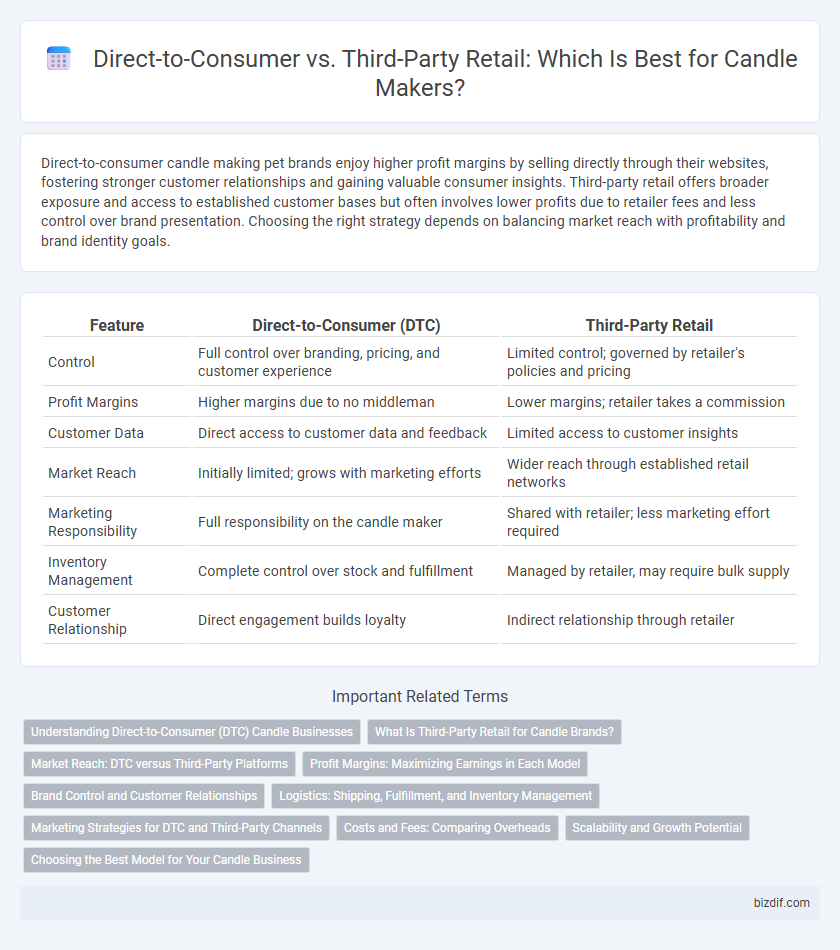Direct-to-consumer candle making pet brands enjoy higher profit margins by selling directly through their websites, fostering stronger customer relationships and gaining valuable consumer insights. Third-party retail offers broader exposure and access to established customer bases but often involves lower profits due to retailer fees and less control over brand presentation. Choosing the right strategy depends on balancing market reach with profitability and brand identity goals.
Table of Comparison
| Feature | Direct-to-Consumer (DTC) | Third-Party Retail |
|---|---|---|
| Control | Full control over branding, pricing, and customer experience | Limited control; governed by retailer's policies and pricing |
| Profit Margins | Higher margins due to no middleman | Lower margins; retailer takes a commission |
| Customer Data | Direct access to customer data and feedback | Limited access to customer insights |
| Market Reach | Initially limited; grows with marketing efforts | Wider reach through established retail networks |
| Marketing Responsibility | Full responsibility on the candle maker | Shared with retailer; less marketing effort required |
| Inventory Management | Complete control over stock and fulfillment | Managed by retailer, may require bulk supply |
| Customer Relationship | Direct engagement builds loyalty | Indirect relationship through retailer |
Understanding Direct-to-Consumer (DTC) Candle Businesses
Direct-to-Consumer (DTC) candle businesses eliminate intermediaries, allowing manufacturers to sell candles directly to customers through online platforms, which enhances profit margins and customer engagement. This model provides valuable customer data that can be leveraged for personalized marketing and product development, increasing brand loyalty in the highly competitive candle market. DTC brands often invest in storytelling and brand experience to differentiate their artisanal or specialty candles from mass-produced options found in third-party retail stores.
What Is Third-Party Retail for Candle Brands?
Third-party retail for candle brands involves selling products through external platforms or stores that act as intermediaries between the brand and consumers, such as Etsy, Amazon, or local boutiques. This approach enables candle makers to tap into established customer bases and expand market reach without managing their own sales infrastructure. Leveraging third-party retail can increase visibility and sales volume but often includes fees, less control over branding, and reliance on the retailer's policies.
Market Reach: DTC versus Third-Party Platforms
Direct-to-consumer (DTC) candle makers maintain full control over branding and customer experience while targeting a specific, loyal audience through personalized marketing and social media engagement. Third-party retail platforms, such as Etsy or Amazon, offer immediate access to a broader market with established traffic, increasing visibility but often at the cost of higher competition and fees. Balancing DTC channels and third-party marketplaces optimizes both niche customer loyalty and expansive market reach, critical for scaling growth in the competitive candle industry.
Profit Margins: Maximizing Earnings in Each Model
Direct-to-consumer candle makers benefit from higher profit margins by eliminating intermediaries, allowing for full control over pricing and customer experience. Third-party retail partners reduce marketing and distribution costs but typically demand wholesale pricing that decreases overall profit per unit. Strategic pricing and volume optimization are essential to maximize earnings, whether managing direct sales channels or collaborating with retail platforms.
Brand Control and Customer Relationships
Direct-to-Consumer candle brands maintain complete control over their brand image, packaging, and pricing, fostering a personalized customer experience that strengthens loyalty and engagement. Third-party retail channels dilute this control, often imposing standardized branding and limited customization options, which can weaken direct customer connections. Managing direct sales enables candle makers to gather valuable customer data and feedback, driving product innovation and tailored marketing strategies.
Logistics: Shipping, Fulfillment, and Inventory Management
Direct-to-consumer candle makers gain greater control over shipping speed, order fulfillment accuracy, and inventory levels, allowing tailored packaging and personalized customer experiences. Third-party retail relies on external logistics partners, which may streamline bulk distribution but often reduces direct oversight of inventory turnover and shipping timelines. Efficient inventory management systems integrated into direct sales platforms minimize stockouts and overstock risks, enhancing overall supply chain responsiveness.
Marketing Strategies for DTC and Third-Party Channels
Direct-to-consumer (DTC) candle brands leverage personalized social media campaigns and email marketing to build direct relationships, gather customer data, and enhance brand loyalty, optimizing conversion rates and customer lifetime value. Third-party retail channels, such as boutique stores and online marketplaces, rely on brand placement, influencer partnerships, and in-store promotions to increase visibility and drive impulse purchases among diverse customer segments. Integrating multi-channel marketing strategies ensures candle makers maximize reach while tailoring messaging to DTC's engagement focus and third-party retail's broad exposure.
Costs and Fees: Comparing Overheads
Direct-to-consumer candle makers typically face lower overhead costs as they bypass third-party retail fees, maintaining full control over pricing and profit margins. Third-party retail involves fees such as consignment percentages, wholesale discounts, and additional marketing costs which reduce overall earnings. Evaluating these expenses is crucial for candle businesses to optimize profitability and scale effectively.
Scalability and Growth Potential
Direct-to-consumer candle makers retain higher profit margins and maintain complete brand control, enabling agile scalability and direct customer engagement for rapid growth. Third-party retail offers access to established markets and broader exposure but involves lower margins and reliance on retailer terms, potentially limiting long-term growth potential. Balancing both strategies allows candle businesses to optimize scalability by combining direct customer insights with expanded distribution channels.
Choosing the Best Model for Your Candle Business
Choosing the best sales model for your candle business depends on brand control, profit margins, and customer engagement. Direct-to-Consumer (DTC) channels offer higher profit margins and stronger brand loyalty by allowing personalized customer experiences and direct feedback. Third-party retail expands reach and simplifies logistics but often reduces profit margins and limits brand storytelling opportunities.
Direct-to-Consumer vs Third-Party Retail Infographic

 bizdif.com
bizdif.com